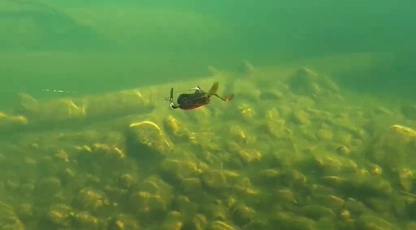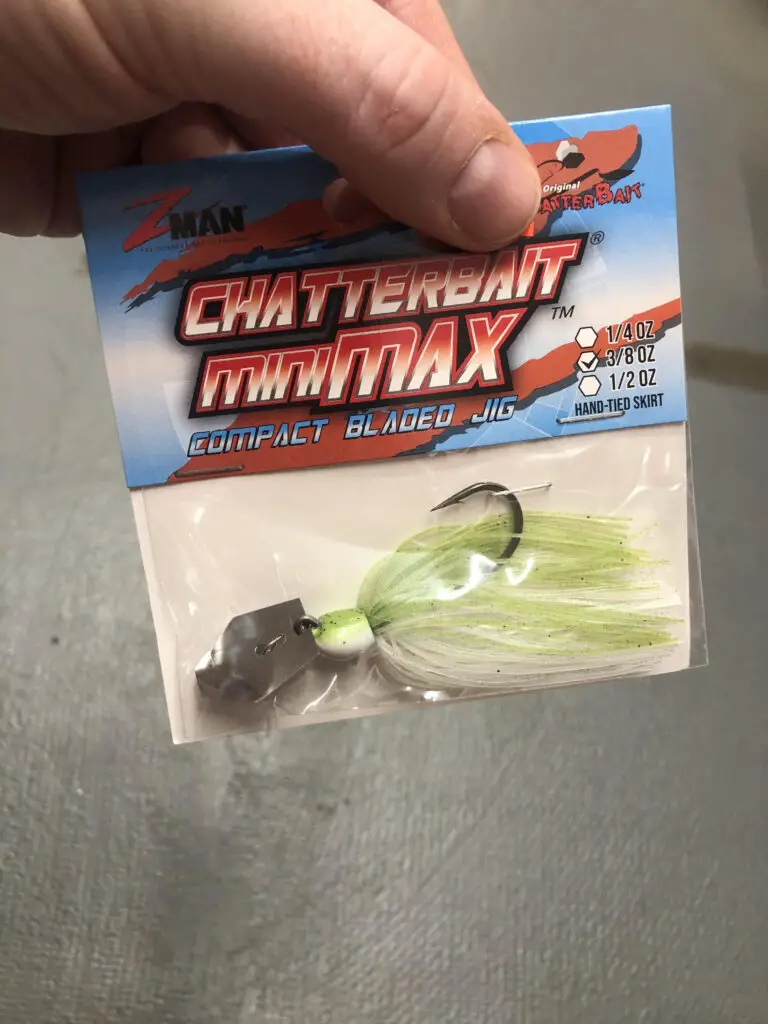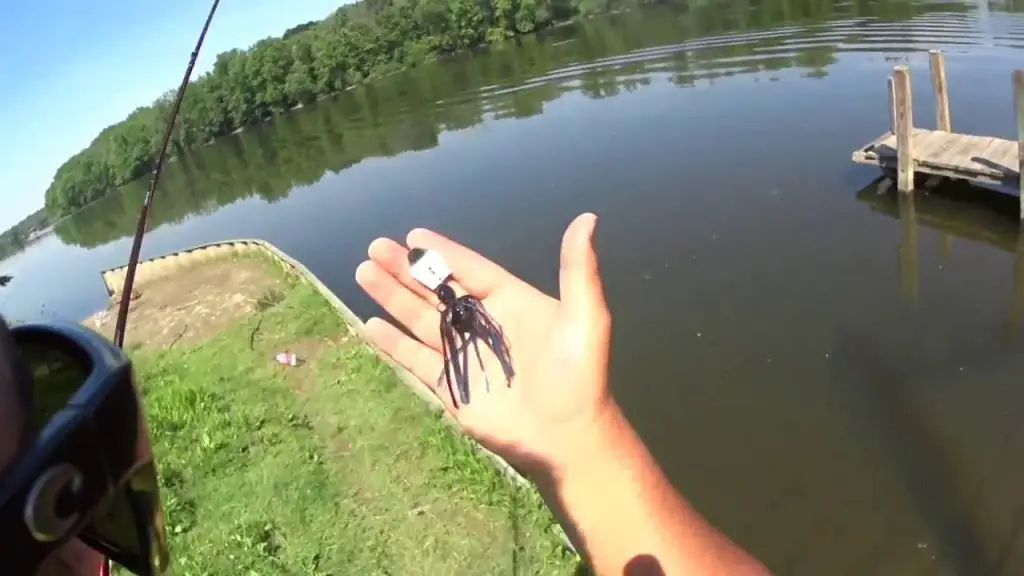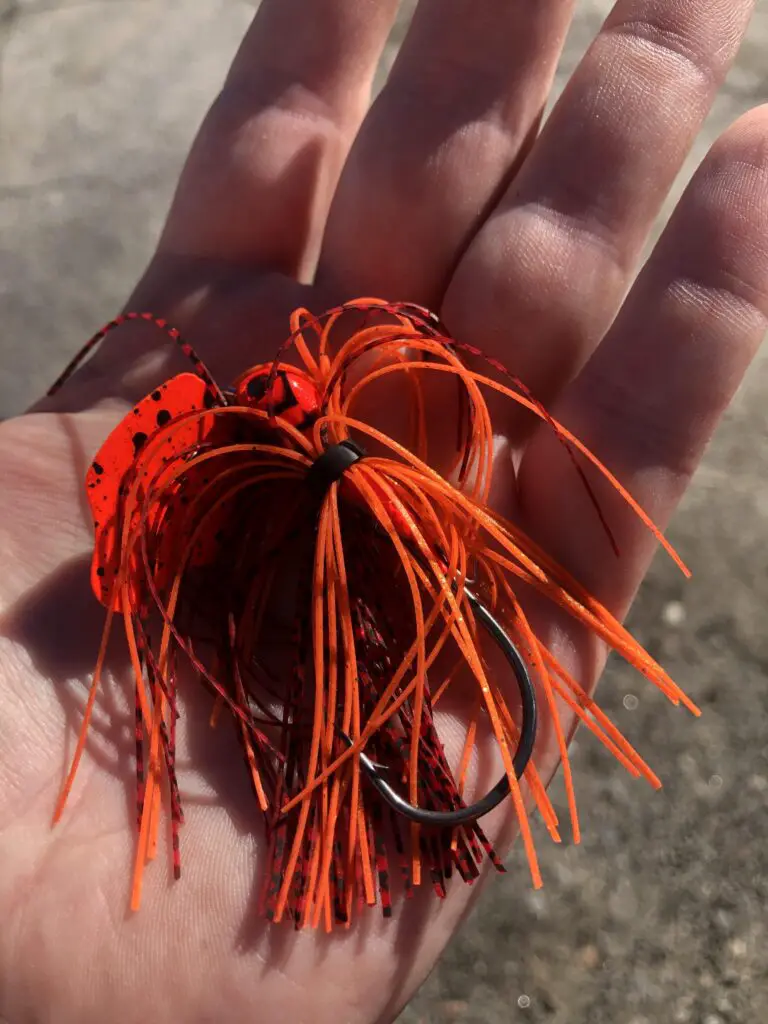To fish a chatterbait, cast near cover or structure, then retrieve steadily while the blade vibrates, creating underwater commotion. Vary retrieval speed and occasionally pause, allowing the lure to flutter downward. Pair with a soft plastic trailer for added action and enticing presentation to bass.
The chatterbait is easily the hottest and most popular lure to hit the fishing industry in the last few years. It’s one of the most misunderstood and underutilized baits for many anglers, but you might be surprised at how much success you can have by properly using the chatterbait.
If you’re like most anglers in the fishing community today, you’re probably looking for a definitive guide on how to fish a chatterbait. We’ve compiled this article to cover some of the best tips and techniques related to chatterbait fishing advice to help you maximize your chances of success with this incredible new lure.
Table of Contents
Chatterbait Lure Overview
If you’re not yet aware of what a chatterbait lure is, now is a good time to become acquainted with it. The chatterbait first hit the scene in 2006 at a professional bass fishing tournament in Florida’s Lake Okeechobee. An up-and-coming angler named Bryan Thrift managed to dominate the competition with a massive 10-fish total weight of 36 lbs 9 ounces, taking the title and putting the chatterbait on the map.

Word started to get around about the chatterbait’s success and demand skyrocketed. Ron Davis of South Carolina first pioneered the lure. He began working on the design 2003 with his father and centered its construction around maximizing the vibration effect of the lure’s distinct six-sided blade. Davis’ father spurred the term chatterbait after noting how the lure’s intense vibration was nearly enough to make an angler’s teeth chatter when reeling it in.
Now, nearly two decades later, the chatterbait has become a go-to lure for professional anglers and many are still experimenting and coming up with new ways to fish it. It’s made of a design that looks very similar to that of a weighted jig that comes with a skirt, but what makes it unique is the hexagonal six-sided blade.
The chatterbait is sometimes called a bladed swim jig or a bladed jig. This blade is specially designed to produce a more intense vibration than a spinnerbait while still offering the flashing and ‘swimming’ visual motion that spinnerbaits are known to have. This more distinct vibration mimics a bait fish as it quickly swims away from predators, which taps into a fish’s instinctual drive to strike at it.

How Does a Chatterbait Work?
What attracts bass to strike a chatterbait most is the sound and vibration it puts out when it’s being retrieved through the water. It’s mostly recommended to be fished like you’d throw a spinnerbait in a simple cast-and-retrieve method. You’ll notice that the chatterbait has a much more pronounced vibration effect compared to any spinnerbait.
Most anglers have come to realize that the chatterbait can also function much like a jig that’s fished along the bottom for bass during cold weather. This is because the chatterbait is similarly designed to be like the jig with the only real difference being the six-sided blade. While a chatterbait isn’t quite as weedless as some jigs can be, it’s still capable of being fished similarly. This opens up a whole new world of possibilities for anglers willing to experiment with this lure.

When to Fish a Chatterbait
It’s sometimes difficult to determine the best weather conditions for fishing a chatterbait. They have many similarities to the classic spinnerbait and it makes sense to compare the two and use them in similar conditions. It’s widely known that spinnerbaits function best when the weather is overcast and slightly windy, especially in the spring and summer.
In my experience, any day where the weather is overcast and there’s enough wind to cause a decent amount of disturbance on the water’s surface is a great day to throw a chatterbait. The lack of sunlight shining into the water helps conceal the lure’s finer details and fools fish into thinking your bladed swim jig is a tasty meal that’s about to get past them.
While most anglers prefer to throw chatterbaits and spinnerbaits on a typical baitcaster, I usually like to fish them with lighter medium-action rods in many cases. Sometimes I’ll use a 7-foot spinning rod with monofilament for fishing with lightweight chatterbaits, but I will move to a medium powered baitcasting rod for heavy bladed jigs. I always use braided line if I’m throwing the bladed jig anywhere around cover where it might become snagged.
The chatterbait is a lure that you should always keep in your tackle box on standby as it can get bites at any time throughout the year. In the following sections, we’ll discuss some of the best strategies to fish a chatterbait during certain times of the year.
Chatterbaits in Spring
One of the most exciting times of the year for any angler is the spring. When the weather begins to warm up and the water temperature climbs past the 50-degree mark, bass will usually explode with activity. When this prespawn feeding time begins, the chatterbait can be your secret weapon to landing some monster bass in the transition areas from deep water to the shallows.
I like to throw a chatterbait across long primary and secondary points during the early spring to search for fish and detect the sections of these structures where bass might be at any given time. By simply throwing the chatterbait out and slowly reeling it in, it’s easy to get a strike from opportunistic bass that are staged on one side of a point, or deep in a channel.
Some of the best places to target are the primary and secondary points leading into a cove with a small stream or creek. Fish like to target prey that are coming into the lake from these small streams and throwing a chatterbait up into the creek and bringing it back toward the lake is a good way to pick up strikes from bass looking for a meal.
Whenever I’m fishing a chatterbait in the spring, I like to use a slow, steady retrieve while keeping it just above the bottom. It’s important to remember that bass will mostly be moving up from the deep waters during this time and will still be using the lake bottom as they move into shallow water. If at any time you feel the vibration from your chatterbait stop while the lure is still moving, it means your bait is probably touching the ground and you need to pull up on the rod tip to keep it at the right depth in the water column.
Also, don’t be afraid of casting the chatterbait into the shallows during the early spring. Most anglers will assume that bass are going to be in much deeper waters, but you’ll be surprised to find quite a few fish in less than 10 feet of water. It’s important to thoroughly fish the chatterbait around these points from shore to channel to get more bites during the spring.

Chatterbaits in Summer
Summer is quite different from spring in locating and catching bass. A chatterbait can come in handy in scenarios when you’re unsure where fish are. This distinctly-designed lure has all the right components to allow you to fish slow or fast to attract bites from hungry bass throughout the year’s hottest months.
I like to beat the banks with a chatterbait during the summer since you really never know quite where bass will be. The chatterbait is the perfect ‘search and destroy’ style lure that allows you to fish as rapidly as you want to locate bass, especially in the early morning hours before the sun gets too high in the sky.
It’s important to fish the chatterbait similarly to what you might use for a spinnerbait. Vary your retrieval speed and cadence occasionally to get a feel for what the bass want. You might also add a yo-yo action in which you quickly pull up on the rod tip and allow the lure to gently fall back down again before replicating the action. Sometimes, I’ll also erratically twitch my rod tip as I retrieve the chatterbait to entice finicky bass to strike if they’re following the lure.
The true strength of a chatterbait is its ability to catch fish at night during the summer. During the hottest months of the year, bass will become most active throughout the nighttime hours to avoid the blazing-hot sun and sweltering heat. The chatterbait’s six-sided blade and the intense vibration it puts out is very similar to that of an actual fish, which makes it one of the best summer lures to use for bass.
I like to fish the chatterbait in coves and around points with cover and structure for bass and other small fish to take refuge. The bladed jig is the perfect nighttime lure during the summer to coax bass into biting as it puts out the exact vibration that fish seek when they hunt for their next meal.
There are a variety of different types of structure and depth changes where the chatterbait is capable of drawing strikes from hungry bass throughout the summer. You can get a sense of how active the fish are by the speed at which you tend to get bites on a chatterbait. During the summer, there are few other lures besides the chatterbait that are capable of enticing big bass to bite when they are notoriously tight-lipped.
Chatterbait in Fall
As the air temperatures drop during the fall, the water temps will follow and bass activity will usually pick up following the hot summer months. Once again, the chatterbait is a great lure that can be used to ‘search’ for bass without relegating your retrieve to one speed or style. There are various ways you can target fish with a chatterbait in the fall.
I like to throw a chatterbait near steep ledges and sharp depth changes during the fall to catch bass transitioning from shallow water back toward the lake’s depths. Throw it in and allow the chatterbait to fall to the depth where your depth finder indicates the fish are staging before you begin your retrieve.
During this time, I will switch to a red and black-colored Z-Man Stealth Blade chatterbait as it closely mimics prey fish and crawfish swimming through the water. I will sometimes allow the lure to fall all the way to the bottom before quickly ripping it upward a few feet and letting it fall before repeating this cadence. This often resembles a crawfish working its way along the bottom of a lake and can be an ideal choice for catching fish during the fall. If you use this method, be sure to fish with braided line and a medium-heavy baitcasting rod and reel that will allow you to pull the lure out of any snags.
It’s often best to let your chatterbait touch or bump the bottom as you retrieve it during the fall. This is mostly due to the fact that bass will be looking for crawfish and other bait fish that can be found near the bottom during the cooler months of fall. If you’re not getting any bites near the bottom, try adjusting your retrieve and reeling in the chatterbait in a similar fashion higher in the water column.
Fall fishing can be somewhat of a guessing game, and trying to locate where bass are in the water column is sometimes tough. The chatterbait is one of the few lures that allows you to fish high and low in the water column thoroughly. As always throughout the year, be sure to vary your retrieval style and speed to figure out what works best during the fall.
Chatterbait in Winter
In winter, bass are typically much more lethargic and sluggish than any other season. The versatile nature of the chatterbait is its strength during any time of the year and it truly helps it to shine during the frigid cold months of winter. I like to try various methods with a chatterbait during the winter to catch bass at different lakes.
Most anglers are not willing to brave the chilly weather and conditions of winter to catch bass, but those who are will find that the chatterbait once again is capable of performing as well as almost any other lure. It’s important to remember that fish must eat throughout the year, including winter, to survive.
During the winter months, bass will usually be staging at or near the bottom, but when they are hunting, they will look for schools of shad or small bait fish. If you have a fish finder, you should be able to navigate your way around the hotspots of your lake and pinpoint where schools of bait fish are swimming. These areas should have bass of all sizes looking to chase shad and pick off a meal.
I’ve caught some of my largest bass fishing around deep flats and shelves in the winter using spinnerbaits, but chatterbaits seem to work even better for this particular application. Once you find a school of bait fish, or an area where they keep appearing on your fish finder, throw the chatterbait in and wind with a steady retrieve to pick up a strike. You will probably have to vary the speed at which you’re retrieving your chatterbait when using this strategy, but once you get a bite, try to match the exact depth and speed to replicate the results.
If you don’t have a fish finder, trying to locate these bait fish schools can be a challenge. Anywhere there is deep structure such as the end of points or deep channels should be a great place to use the chatterbait. You can cast the bait all around you clockwise or counterclockwise to cover as much water as possible to pick up strikes in the winter season.
During these times, I prefer to fish with a smaller chatterbait that’s either ⅛ ounce or ⅜ ounce size. The best colors are typically white, which will usually match the shad or bait fish that bass are looking to chase during this time. Be ready to get a strike at any time as the fluttering motion a chatterbait has when falling sometimes triggers a bass to bite during the winter months when food is scarce.
How to Use a Chatterbait
| Bass Fishing Scenario | How to Use Chatterbait Lure |
|---|---|
| Muddy or Stained Water | Chatterbaits are excellent in murky or stained water due to their strong vibration and flashing blades. In these conditions, bass rely more on their lateral line to detect movement and vibrations. Choose darker colors to create a strong silhouette. |
| Grass Beds or Weedy Areas | Chatterbaits are great for weed lines and grass beds because their design allows them to be fished through thick cover without getting snagged. Use a steady retrieve, occasionally ripping it free if it gets hung in the weeds. This can trigger reaction strikes from bass hiding in the vegetation. |
| Shallow Flats | During the early morning or late evening when bass are feeding in shallow flats, use a chatterbait. It imitates the small fish and other prey items that bass feed on in these areas. Experiment with retrieval speed and action. |
| Pre-Spawn | In areas where different habitats meet, such as where a rocky bottom transitions to a sandy bottom or where shallow water becomes deep, bass often wait to ambush prey. Use a chatterbait to imitate a vulnerable prey moving through these areas. |
| Post-Spawn | In the post-spawn, bass are often lethargic and can be found in deeper water. Use a heavy chatterbait and slow your retrieve to get down to these deeper fish. |
| Baitfish Schools | If you observe bass feeding on a school of baitfish, use a silver or white chatterbait to mimic the baitfish. Vary retrieval speed and occasionally twitch the rod tip to imitate the erratic movements of a wounded baitfish. |
| Dock Fishing | When bass are taking cover under docks and other structures, a chatterbait can be a great option. Its wide wobbling action can lure bass out from under cover. Try skipping your chatterbait under the dock for a sneaky approach. |
| Fall Fishing | During the fall, bass often feed heavily on baitfish to prepare for winter. Use a chatterbait to imitate these baitfish. Try to match the size and color of the local baitfish as closely as possible. |
| Winter Fishing | In the cold water of winter, bass are less active and feed less frequently. However, a chatterbait can still be effective. Use a slower retrieve and choose a chatterbait with a smaller blade for a more subtle vibration. |
| Transition Areas | In areas where different types of habitats meet, such as where a rocky bottom transitions to a sandy bottom or where shallow water becomes deep, bass often wait to ambush prey. Use a chatterbait to imitate a vulnerable prey moving through these areas. |
Conclusion
One good rule of thumb for when to use the chatterbait is simple: when all other baits and lure presentations don’t seem to work, try a chatterbait.
Learning when and where to use a chatterbait is best done on the water. It’s important that you practice and learn the different ways you can use the chatterbait in the lakes and ponds where you fish for bass. As many other anglers have, you’ll find that this unique lure is quite possibly one of the best fish-catching innovations that has emerged in recent years.

